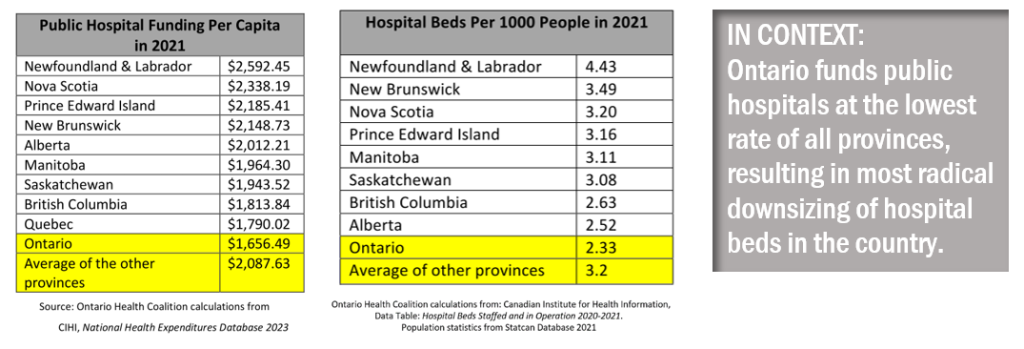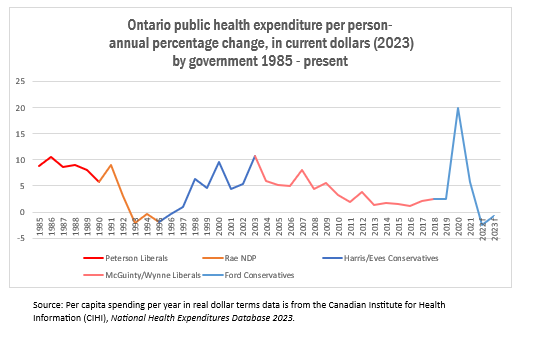ANALYSIS & FACT CHECKER: Quick Facts & Analysis + Fact Checker: Ford government’s health care funding
Posted: November 11, 2024
(November 10, 2024)
Quick Facts & Analysis
What is the Ford government doing re. health funding & what it means
On October 30, the Ford government released its Fall Economic Statement. With high-rotation ads everywhere (paid by taxpayers) touting the record of the Ford government, and rumours of a spring election in the air, it is useful to give a quick rundown of the facts.
What was in last week’s Fall Economic Statement?
Priorities: What is new in the economic update shows the priorities for the government. The largest part of the revision to the expenditure forecast for this financial year is the $200 per taxpayer cash give away ($3 billion) just before the rumoured election. That $3 billion giveaway means $3 billion that is not going to address the health care crisis or other needed services for Ontarians. Ontario continues to fund all our public services at the lowest rate per person of any province in Canada and the financial plan does not change that.
- Real dollar cuts are planned for all public services overall: The plan is to increase public services funding an average of 1.88% per year for the next two years. This doesn’t even match their inflation forecast of slightly over 2% per year, meaning real dollar cuts.
- The 2024 Budget actually cut health care funding compared to last year. This funding cut is partly explained because last year shows a significant bump up due to one-time retroactive wage payments (going back to 2019) made in 2023/24 to pay for the Ford government’s failed wage suppression policy for nurses, health care workers and other public sector employees (Bill 124). The courts ruled Bill 124 to be unconstitutional. It resulted in real dollar cuts in wages for public and non-profit health care workers throughout the pandemic, worsening the staffing shortages. In bad news, the rest of the funding cut this year, however, is also explained by damaging planned cuts in health care service levels.
-
- Note: the provincial government held hospital funding throughout the most recent financial year in real dollar cuts (less than 1% increase while inflation was running at triple or more than rate) right up until the final weeks of the financial year, throwing most of our public hospitals into deficit, leaving operating rooms closed and underutilized while patients waited, forcing emergency departments and other services into repeated closures, and leaving hospitals with critical staffing shortages compromising care and resulting in higher costs for overtime and private staffing agencies. Only at the very end of the financial year did they give the bump up for the retroactive wage reopener, enabling them to say they gave a significant increase last year, while in fact they held it back while services closed and the staffing crisis worsened in many communities. At the same time, they gave huge increases to for-profit clinics. See Appendix III below for sources and details.
- Going forward — for 2025-27 — the health care funding plan is marginally more than public services (education, the environment, social services etc.) but is mostly just in line with inflation; certainly not enough to deal with the hospital, primary care, long-term care and home care crises that they have had a large hand in creating. The plan is for 2.3% average annual increases, just slightly above the rate of inflation. In both health care and all public services, funding does not keep pace with population growth and inflation. That means less services, not more.
- Hospital crisis continues unabated: Despite our efforts, they are sticking (for now) to their plan to add just 3,000 hospital beds over ten years, nowhere near what is needed to address patients stacked in hallways and restore capacity to meet population need. (Note: After massive downsizing followed by a refusal to expand hospital capacity to meet population growth, Ontario has the fewest hospital beds staffed and in operation of any province in Canada, and in fact is dead last in hospital beds per person among our peer nations.)
- No respite for the long-term care (LTC) wait list: There is virtually no progress in dealing with the 39,000-person wait list for long-term care. At the same time, there are more than LTC 30,000 beds to be closed in 2025 because their licenses end and the homes do not meet the building standards set 25 years ago. Note: those homes had decades to redevelop to meet current standards. The Ford government has been extending those licenses and continues with their unsuccessful plan to give the majority of beds to for-profit corporations. Despite having given them repeated funding increases, the beds are not getting built. In the 2024 Budget the Ford government claims to have added 2,246 new LTC beds, far less than the 15,000 promised for 2023. Now they claim to have added 2,385 (at 32 homes). That’s an extra 139 beds over seven months. At that rate it will take 125 years to add the 30,000 beds they promised by 2028. Worsening the crisis, at least eight LTC homes have announced that they will close. In the good news, the government announced just over $20 million to support Behavioural Supports in existing homes (not enough, but it is something).
- On the primary care crisis: What is new in the Fall Economic Statement is very little — $17.7 million but not until two years from now, after the election in 2026–27 — to expand the Ontario Learn and Stay Grant (OLSG). Notably, there is also an anti-immigrant PR stunt by Doug Ford, previously announced and also in the Fall Economic Statement, supposedly limiting medical school spaces for international students. In truth, we only have a tiny number of international medical students in Ontario so this was meaningless in terms of medical school spaces but dangerous in that it follows the despicable U.S. political trend of stoking anti-immigrant sentiment for political gain.
- Also notable on primary care, they have appointed Dr. Jane Philpott to chair a taskforce to come up with recommendations on the primary care crisis (already announced and also in the Fall Economic Statement). This may be helpful but it must be noted that it has all the appearance of performance over substance. It is beyond late to start to make recommendations. Much better would have been actually moving forward immediately with funding Community Health Centres to expand their services, and creating more public non-profit teams, Community Health Centres, Nurse Practitioner-led clinics and Aboriginal Health Centres.
- Nothing new (beyond what was in the Budget) for nurse training.
- Some funding for ALS clinics: $13 million over three years, starting in 2024–25, to establish an Amyotrophic Lateral Sclerosis (ALS) provincial program. This program will support patient care at Ontario’s five regional multidisciplinary ALS clinics.
- Funding increase for fertility: an additional $150 million over two years to expand government-funded in vitro fertilization (IVF) and increase the capacity of fertility clinics (these are mostly private, we believe).
- There is also a section on booze and many sections on long-term building projects (a slew of which are privatized, as in long-term care explained above).
________________________________________
FACT CHECKER: What is the Ford government doing
re. health care & hospital funding?
In response to media stories about the health care crisis rolling out across Ontario, the Ford government consistently states that they have increased health care funding since they took office.
The recent figures they use are as follows:
“Under the leadership of Premier Ford, our government is making the largest investment in health care in the province’s history. Since 2018, our government has increased the health-care budget by over 31 per cent, investing over $85 billion into the system this year alone.”
Has there been a 31% increase to the provincial health care budget? Not in real dollars.
Since the Ford government took office, they increased the health care budget by $23.6 billion in nominal dollars. To calculate the 31% increase they used nominal (not inflation adjusted) dollars. Using nominal dollars is manipulative. It doesn’t mean that we have 31% more buying power or 31% more services. Economists use “real dollars” to measure funding increases in constant (inflation adjusted) dollars (more on this below). In real dollars, the increase since the Ford government took office is 20.3% up to last year. Notably, that includes last year’s one-time bump up for the Bill 124 wage reopener. In context, from 2018 when Ford was elected to 2024 Ontario’s population grew by 12.6% and the population over age 65 (who need more health care services) grew by 22%. Source: Public Accounts, Government of Ontario each year from 2018-2024. See Appendix I for more sources and details.
Is it the largest investment in the province’s history? Not really.
Almost every government could say that they have spent the most on health care in history (and some have claimed that) because each year the population grows and every year there is inflation. Economists use “real dollars” – spending over years calculated in current dollars – and measure spending per person to evaluate whether or not there have been actual increases or cuts per person. Appendix I breaks down the real dollar funding for health care under the Ford government & Appendix II shows the percentage change in health care funding for each Ontario government going back for 50 years. You can see the Ford government has, for some years, actually shrunk health funding in real dollars and per person since it took office, some years it grew spending, and over its term in office it did not make the largest investment in our history. Also of note, in the years with really significant increases in the height of the pandemic, the federal government gave $29 billion in special COVID funding to the provinces.
Ontario funds health care and all public services at the lowest rate in Canada
This results in more user fees & less services.
(“Per capita” means per person)
FAO is the Financial Accountability Office of Ontario. You can find these charts here.
Real dollar cuts to public hospitals, huge funding increases for private clinics
In the most recent budget year, the Ford government held hospital funding below inflation — in real dollar cuts — all year, throwing hospitals into deficit even while we had the worst staffing crisis and hospital closures we have ever seen. Then, only in the last weeks at the very end of the fiscal (financial) year, did they announce a bump up in funding. This enables the Ford government to say that they increased funding in the most recent budget year, but they did it too late to allow hospitals to hire staff, save services, stop closures and so on. In fact, in order to cover staffing needs, hospitals had to incur extra costs for overtime and private for-profit staffing agencies (that cost up to three times more per nursing hour) while receiving real dollar cuts.
Pouring public money into higher cost health privatization schemes
For-profit clinics and hospitals charge higher fees to the public system (OHIP) and they extra-bill patients on top. For-profit corporations also have no interest in putting money they take from their patients into improving the public health care system. They take the profits out of the health system for themselves and their investors.
- CBC uncovered contracts that show that the Ford government is using our public tax funds to pay more than double for surgeries at a private for-profit hospital.
- The Kingston Health Coalition uncovered contracts that show that they are paying 56% more to do cataract surgeries at a private clinic.
- Across the board, the Ford government is paying a premium of 20% from OHIP billings alone (not including extra user fees charged to patients) at private clinics: they are funding public hospitals approximately $500 per surgery and private clinics are getting $605 per surgery and the for-profit hospital (the Don Mills Surgical Unit) is getting $1,264 for the same surgery.
The same public funding would have provided far more surgeries in public hospitals.
APPENDIX I: Breakdown of Ford Government health funding per year
Nominal dollar health funding since the Ford government took office:
An accurate accounting of what the government has spent on health care since it took office can be found in the Public Accounts of Ontario. Each year, in its Public Accounts the government publishes an Annual Report including all revenues, all expenses and multi-year comparisons. This is what Public Accounts says for Health Sector expenditures for each year since 2018 when the Ford government was elected. Note: health sector includes all the one-time COVID funding:
2018/19: $61.9 billion
2019/20: $63.7 billion
2020/21: $69.5 billion
2021/22: $75.8 billion
2022/23: $78.5 billion
2023/24: $85.5 billion – This includes the one time funding for retropayments for Bill 124
Total increase in annual health budget in nominal dollars (not real dollars): $23.6 billion.
($85.5 billion – $61.9 billion.)
Real dollar health funding change since the Ford government took office:
Please note: these reports are in current dollars for the year that the report is made. To calculate real dollar spending increases, we need to adjust those figures for inflation. (For eg. a cheese burger may have cost 12 cents in 1950 but the average income was reportedly $3,300. The value of a dollar over time changes.) To use nominal dollars to measure government expenditure on social programs will always make it look like they are funding programs much more. Similarly, if we used nominal dollars to measure government revenues – that is the money they take in from taxes, federal government transfers and government business enterprises – it would also look like revenues have skyrocketed. To calculate real dollar costs, we have to adjust to what economists call “real” dollars – or inflation adjusted dollars.
- 2018/19 – 2019/20:health sector funding increased by $1.8 billion. This is a 2.9% increase. According to Statistics Canada, health care inflation for April 2019- April 2020 was 1.4%. Thus, in the real dollar increase was approx. 1.5%
- 2019/20 – 2020/21:health sector funding increased by $5.8 billion. This is a 9.1% increase. (This was the pandemic.) Health care inflation for April 2020 – April 2021 was 2.2%. Thus, the real dollar increase was approx. 6.9%.
- 2020/21 – 2021/22:health sector funding increased by $6.3 billion. This is an 9% increase. (Again, this was the pandemic.) Health care inflation for April 2021 – April 2022 was 2.1%. Thus, the real dollar increase was 6.9%.
- 2021/22 – 2022/23:health sector funding increased by $2.7 billion. This is a 3.6% increase. Health care inflation April 2022 – April 2023 was 5.3%. Thus, there was a real dollar decrease of – 1.7%.
- 2022/23-2023/24:health sector funding increased by $7 billion. This is a 9% increase. (This includes the one-time funding for retroactive pay increases that were awarded after the courts struck down Bill 124- the Ford government’s wage caps of 1% on nurses, health professionals and public non-profit health care staff.) Health care inflation for April 2023- April 2024 was 2.3%. Thus, the real dollar increase was approximately 6.7%.
Total health sector funding percentage change using real dollars, approximately 20.3%
From 2018 – 2024 the population grew by 12.6% and the population over age 65 grew by 22%. In order to just maintain existing services, we would need funding to accord with population growth, population aging, and the impact of COVID/long-COVID over this period.
Federal Pandemic Funding:
The amount of funding in the last six years includes the special COVID funding that was flowed from the federal government to the provinces during the pandemic. For three years (2020-2022), that special funding amounted to $29 billion.
APPENDIX II: The evidence re. Ontario health funding over 50 years
APPENDIX III: The evidence re. public hospital funding
The story these numbers tell is that the Ford government held hospital funding in real dollar cuts all year, throwing hospitals into deficit even while we had the worst staffing crisis and hospital closures we have ever seen. Then, only in the last weeks at the very end of the fiscal (financial) year, did they announce a bump up in funding.
The last minute funding increase enables the Ford government to say that they increased funding in the most recent budget year, but they did it too late to allow hospitals to hire staff, save services, stop closures, and mitigate extra costs that hospitals had to pay for overtime, locums, for-profit staffing agencies and other consequences of severe understaffing such as accidents, injuries and medical errors. In any case, that funding bump up was mostly to fund one-time retroactive wage increases for health care staff after Bill 124 – the legislation that put a 1% cap on nurse, health professional and health care workers’ wages – was struck down by the courts.
Click here for printable version of the more in-depth fact checker











